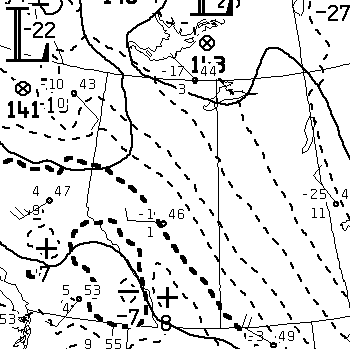| Activity/Topic | |
|---|
| Prepare a short range (e.g. 48-hr) weather forecast (repeating exercise) | ✔ |
| Calculations using hydrostatic law, ideal gas law, sat.vap. press. tables | ✔ |
| Compute geostrophic wind from height contour spacing | ✔ |
| Compute rate of temperature advection | ✔ |
| Plot a sounding | ✔ |
| Use the skew-T chart to compute various properties (LCL, LFC, potential temperatures etc.) | ✔ |
| Plot time series of thickness alongside time series of layer-mean temperature | ✔Assig. 1 |
| Write a program to compute saturation vapour pressure | |
| Plot hodograph, infer thermal wind | ✔ |
| Plot a cross-section from radiosonde data at stations along a transect | ✔ |
| Analyses and forecasts of vertical motion available from NWP models | ✔ |
| Compare NWP fields for divergence, thermal advection and vertical motion (context: QG paradigm) | ✔ |
| Using GrADS (Grid Analysis and Display System) to display height field (using grib2 files from GEM prog) | ✔ |
| Use GrADS to prepare a chart of the vertical vapour flux | ✔ |
| Case study of frontogenesis in relation to deformation | |
| Compute crop evapotranspiration (vertical eddy flux of water vapour) from time series of velocity and humidity | |
| Plot diurnal cycle of components of the surface energy budget | |
| Change in heat storage inferred from subsequent soundings. Implied 12-hr mean surface heat flux | |
| Generate weather chart(s) for a past day from web-accessible archive (reanalysis) | ✔ |
| Generate chart giving climatological isobaric height contours from web-accessible archive | |
| Online computation/display of air parcel back-trajectories based on NWP wind fields | |
| Compute a histogram and probability density function from given data | ✔ Assig. 3 |
| Calculating Heidke skill score | ✔Assig. 2 |
| Student weather briefings (teams of 2) | ✔ |
| Theme | Activity/Topic |
|---|
| Vocabulary & meaning of equations | Derive statement of mass conservation in Cartesian coordinates. Express that equation in vector notation. Unit vectors. Meaning of grad operator | |
| Lagrangian derivative. Conserved variables. Conservation of thermodynamic energy. Velocity divergence | |
| The equations of motion in vector form; in component form relative to local rotating Cartesian coordinates | |
| Atmospheric Paradigms | Geostrophic wind model | |
| Continuity equation in isobaric coordinates. Height-integrated continuity equation. Relationship between horizontal divergence and vertical motion. Level(s) of non-divergence | |
| Thermal wind | |
| The quasi-geostrophic model. Vorticity equation. Omega equation. Significance of vorticity advection and thermal advection | |
| Everyday tools | Thermodynamic chart. Hodograph | |
| Hypsometric equation. Dry adiabatic lapse rate. Natural coordinate system | |
| Potential temperature. Thermodynamic chart. Energetics of vertical motion | |
| Water vapour calculations. Dewpoint lapse rate. Mixing ratio lines on the thermodynamic chart | |
| METARs, meteograms, TAF, PIREP, Graphical Area Forecast (GFA) | |
| Vertical motion on the synoptic scale. Relationship with precipitation. Precipitable water. Vertical flux of water vapour | |
| Further differential properties of the wind field: deformation | |
| Satellite data | GOES, POES, and exotic meteorological satellites | |
| Unresolved motion | Decomposition into resolved/unresolved scales of motion. Fundamental view of friction. The closure problem. Eddy diffusion parameterization | |
| Heat, mass and momentum exchange between the surface and the free troposphere. Unresolved ("turbulent") vertical fluxes in the atmospheric boundary layer. The surface layer ("constant flux layer"). The surface energy balance | |
| Fronts & frontogenesis |
| NWP | MSC's Global Environmental Multiscale model - model dynamics | |
| MSC's GEM model - parameterizations | |
| NCEP's NAM model |
| Re-analyses |
